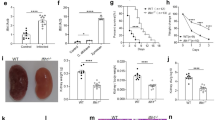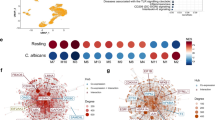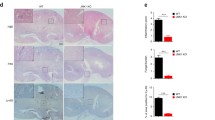Abstract
The induction of host defense against Candida species is initiated by recognition of the fungi by pattern recognition receptors and activation of downstream pathways that produce inflammatory mediators essential for infection clearance. In this study, we present complementary evidence based on transcriptome analysis, genetics, and immunological studies in knockout mice and humans that the cytosolic RIG-I-like receptor MDA5 (IFIH1) has an important role in the host defense against C. albicans. Firstly, IFIH1 expression in macrophages is specifically induced by invasive C. albicans hyphae, and patients suffering from chronic mucocutaneous candidiasis (CMC) express lower levels of MDA5 than healthy controls. Secondly, there is a strong association between missense variants in the IFIH1 gene (rs1990760 and rs3747517) and susceptibility to systemic Candida infections. Thirdly, cells from Mda5 knockout mice and human peripheral blood mononuclear cells (PBMCs) with different IFIH1 genotypes display an altered cytokine response to C. albicans. These data strongly suggest that MDA5 is involved in immune responses to Candida infection. As a receptor for viral RNA, MDA5 until now has been linked to antiviral host defense, but these novel studies show unexpected effects in antifungal immunity as well. Future studies are warranted to explore the potential of MDA5 as a novel target for immunotherapeutic strategies.





Similar content being viewed by others
References
Gudlaugsson O, Gillespie S, Lee K et al (2003) Attributable mortality of nosocomial candidemia, revisited. Clin Infect Dis 37(9):1172–1177
Wisplinghoff H, Bischoff T, Tallent SM, Seifert H, Wenzel RP, Edmond MB (2004) Nosocomial bloodstream infections in US hospitals: analysis of 24,179 cases from a prospective nationwide surveillance study. Clin Infect Dis 39(3):309–317
Miller LG, Hajjeh RA, Edwards JE Jr (2001) Estimating the cost of nosocomial candidemia in the united states. Clin Infect Dis 32(7):1110
Zaoutis TE, Argon J, Chu J, Berlin JA, Walsh TJ, Feudtner C (2005) The epidemiology and attributable outcomes of candidemia in adults and children hospitalized in the United States: a propensity analysis. Clin Infect Dis 41(9):1232–1239
Smeekens SP, van de Veerdonk FL, Kullberg BJ, Netea MG (2013) Genetic susceptibility to Candida infections. EMBO Mol Med 5(6):805–813
Plantinga TS, Johnson MD, Scott WK et al (2012) Toll-like receptor 1 polymorphisms increase susceptibility to candidemia. J Infect Dis 205(6):934–943
Glocker EO, Hennigs A, Nabavi M et al (2009) A homozygous CARD9 mutation in a family with susceptibility to fungal infections. N Engl J Med 361(18):1727–1735
van de Veerdonk FL, Plantinga TS, Hoischen A et al (2011) STAT1 mutations in autosomal dominant chronic mucocutaneous candidiasis. N Engl J Med 365(1):54–61
Liu L, Okada S, Kong XF et al (2011) Gain-of-function human STAT1 mutations impair IL-17 immunity and underlie chronic mucocutaneous candidiasis. J Exp Med 208(8):1635–1648
Babula O, Lazdāne G, Kroica J, Linhares IM, Ledger WJ, Witkin SS (2005) Frequency of interleukin-4 (IL-4) -589 gene polymorphism and vaginal concentrations of IL-4, nitric oxide, and mannose-binding lectin in women with recurrent vulvovaginal candidiasis. Clin Infect Dis 40(9):1258–1262
Smeekens SP, Ng A, Kumar V et al (2013) Functional genomics identifies type I interferon pathway as central for host defense against Candida albicans. Nat Commun 4:1342
Zheng X, Wang Y, Wang Y (2004) Hgc1, a novel hypha-specific G1 cyclin-related protein regulates Candida albicans hyphal morphogenesis. EMBO J 23(8):1845–1856
Trynka G, Hunt KA, Bockett NA et al (2011) Dense genotyping identifies and localizes multiple common and rare variant association signals in celiac disease. Nat Genet 43(12):1193–1201
Oosting M, Ter Hofstede H, Sturm P et al (2011) TLR1/TLR2 heterodimers play an important role in the recognition of Borrelia spirochetes. PLoS One 6(10):e25998
Lehrer RI, Cline MJ (1969) Interaction of Candida albicans with human leukocytes and serum. J Bacteriol 98(3):996–1004
Kanehisa M, Goto S (2000) KEGG: Kyoto Encyclopedia of Genes and Genomes. Nucleic Acids Res 28(1):27–30
da Huang W, Sherman BT, Lempicki RA (2009) Systematic and integrative analysis of large gene lists using DAVID bioinformatics resources. Nat Protoc 4(1):44–57
Takeuchi O, Akira S (2010) Pattern recognition receptors and inflammation. Cell 140(6):805–820
International HapMap Consortium, Frazer KA, Ballinger DG et al (2007) A second generation human haplotype map of over 3.1 million SNPs. Nature 449(7164):851–861
Gabriel SB, Schaffner SF, Nguyen H et al (2002) The structure of haplotype blocks in the human genome. Science 296(5576):2225–2229
Qu HQ, Marchand L, Grabs R, Polychronakos C (2008) The association between the IFIH1 locus and type 1 diabetes. Diabetologia 51(3):473–475
Liu S, Wang H, Jin Y et al (2009) IFIH1 polymorphisms are significantly associated with type 1 diabetes and IFIH1 gene expression in peripheral blood mononuclear cells. Hum Mol Genet 18(2):358–365
Smyth DJ, Cooper JD, Bailey R et al (2006) A genome-wide association study of nonsynonymous SNPs identifies a type 1 diabetes locus in the interferon-induced helicase (IFIH1) region. Nat Genet 38(6):617–619
Downes K, Pekalski M, Angus KL et al (2010) Reduced expression of IFIH1 is protective for type 1 diabetes. PLoS One 5(9)e12646
van der Lee R, Buljan M, Lang B et al (2014) Classification of intrinsically disordered regions and proteins. Chem Rev 114(13):6589–6631
Wu B, Peisley A, Richards C et al (2013) Structural basis for dsRNA recognition, filament formation, and antiviral signal activation by MDA5. Cell 152(1–2):276–289
Hou F, Sun L, Zheng H, Skaug B, Jiang QX, Chen ZJ (2011) MAVS forms functional prion-like aggregates to activate and propagate antiviral innate immune response. Cell 146(3):448–461
Chen G, Zhou D, Zhang Z et al (2012) Genetic variants in IFIH1 play opposite roles in the pathogenesis of psoriasis and chronic periodontitis. Int J Immunogenet 39(2):137–143
Yang H, Wang Z, Xu K et al (2012) IFIH1 gene polymorphisms in type 1 diabetes: genetic association analysis and genotype–phenotype correlation in Chinese Han population. Autoimmunity 45(3):226–232
Sutherland A, Davies J, Owen CJ et al (2007) Genomic polymorphism at the interferon-induced helicase (IFIH1) locus contributes to Graves’ disease susceptibility. J Clin Endocrinol Metab 92(8):3338–3341
Cen H, Wang W, Leng RX et al (2013) Association of IFIH1 rs1990760 polymorphism with susceptibility to autoimmune diseases: a meta-analysis. Autoimmunity 46(7):455–462
Martínez A, Santiago JL, Cénit MC et al (2008) IFIH1-GCA-KCNH7 locus: influence on multiple sclerosis risk. Eur J Hum Genet 16(7):861–864
Nejentsev S, Walker N, Riches D, Egholm M, Todd JA (2009) Rare variants of IFIH1, a gene implicated in antiviral responses, protect against type 1 diabetes. Science 324(5925):387–389
van der Graaf C, Kullberg BJ, Joosten L et al (2005) Functional consequences of the Asp299Gly Toll-like receptor-4 polymorphism. Cytokine 30(5):264–268
van der Graaf CA, Netea MG, Drenth IP, te Morsche RH, van der Meer JW, Kullberg BJ (2003) Candida-specific interferon-gamma deficiency and toll-like receptor polymorphisms in patients with chronic mucocutaneous candidiasis. Neth J Med 61(11):365–369
Van der Graaf CA, Netea MG, Morré SA et al (2006) Toll-like receptor 4 Asp299Gly/Thr399Ile polymorphisms are a risk factor for Candida bloodstream infection. Eur Cytokine Netw 17(1):29–34
Liu F, Shinomiya H, Kirikae T, Hirata H, Asano Y (2004) Characterization of murine grancalcin specifically expressed in leukocytes and its possible role in host defense against bacterial infection. Biosci Biotechnol Biochem 68(4):894–902
Lollike K, Johnsen AH, Durussel I, Borregaard N, Cox JA (2001) Biochemical characterization of the penta-EF-hand protein grancalcin and identification of L-plastin as a binding partner. J Biol Chem 276(21):17762–17769
Trinklein ND, Aldred SF, Hartman SJ, Schroeder DI, Otillar RP, Myers RM (2004) An abundance of bidirectional promoters in the human genome. Genome Res 14(1):62–66
Michalak P (2008) Coexpression, coregulation, and cofunctionality of neighboring genes in eukaryotic genomes. Genomics 91(3):243–248
Roes J, Choi BK, Power D, Xu P, Segal AW (2003) Granulocyte function in grancalcin-deficient mice. Mol Cell Biol 23(3):826–830
Kato H, Takeuchi O, Sato S et al (2006) Differential roles of MDA5 and RIG-I helicases in the recognition of RNA viruses. Nature 441(7089):101–105
Rice GI, del Toro Duany Y, Jenkinson EM et al (2014) Gain-of-function mutations in IFIH1 cause a spectrum of human disease phenotypes associated with upregulated type I interferon signaling. Nat Genet 46(5):503–509
Majer O, Bourgeois C, Zwolanek F et al (2012) Type I interferons promote fatal immunopathology by regulating inflammatory monocytes and neutrophils during Candida infections. PLoS Pathog 8(7):e1002811
Netea MG, Gow NA, Munro CA et al (2006) Immune sensing of Candida albicans requires cooperative recognition of mannans and glucans by lectin and Toll-like receptors. J Clin Invest 116(6):1642–1650
Djeu JY (1990) Role of tumor necrosis factor and colony-stimulating factors in phagocyte function against Candida albicans. Diagn Microbiol Infect Dis 13(5):383–386
Ferwerda G, Girardin SE, Kullberg BJ et al (2005) NOD2 and toll-like receptors are nonredundant recognition systems of Mycobacterium tuberculosis. PLoS Pathog 1(3):279–285
Rahman A, Sobia P, Gupta N, Kaer LV, Das G (2014) Mycobacterium tuberculosis subverts the TLR-2-MyD88 pathway to facilitate its translocation into the cytosol. PLoS One 9(1):e86886
Stamm LM, Morisaki JH, Gao LY et al (2003) Mycobacterium marinum escapes from phagosomes and is propelled by actin-based motility. J Exp Med 198(9):1361–1368
Wagener J, Malireddi RK, Lenardon MD et al (2014) Fungal chitin dampens inflammation through IL-10 induction mediated by NOD2 and TLR9 activation. PLoS Pathog 10(4):e1004050
Acknowledgments
We thank Martin Oti for the helpful discussions. MJ and MGN were supported by an ERC Consolidator Grant (nr. 310372 to MGN). RvdL and MAH were supported by the Virgo Consortium, funded by the Dutch government (FES0908), and by the Netherlands Genomics Initiative (050-060-452). CW was supported by the ERC Advanced Grant, ERC-671274. XW was supported by NSFC 11101321 and NSFC 61263039 grants.
Conflict of interest
The authors declare that they have no conflict of interest.
Author information
Authors and Affiliations
Corresponding author
Additional information
M. Jaeger, R. van der Lee, and S.-C. Cheng contributed equally to this work.
Electronic supplementary material
Below is the link to the electronic supplementary material.
ESM 1
(DOCX 7.91 mb)
Rights and permissions
About this article
Cite this article
Jaeger, M., van der Lee, R., Cheng, SC. et al. The RIG-I-like helicase receptor MDA5 (IFIH1) is involved in the host defense against Candida infections. Eur J Clin Microbiol Infect Dis 34, 963–974 (2015). https://doi.org/10.1007/s10096-014-2309-2
Received:
Accepted:
Published:
Issue Date:
DOI: https://doi.org/10.1007/s10096-014-2309-2




